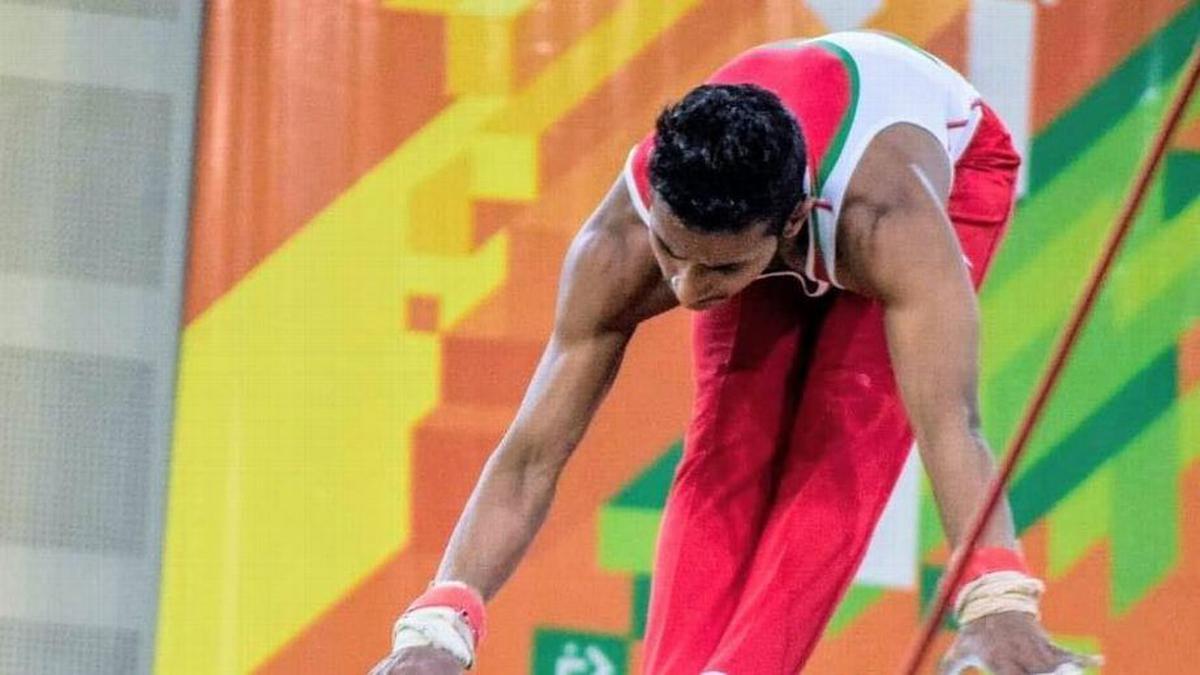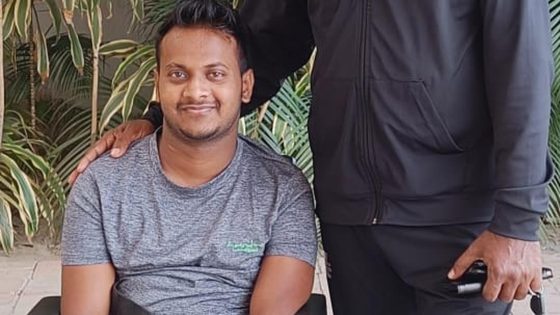Sandeep Kumar Pal was a youth national champion in gymnastics before a training accident four years ago left him a quadriplegic. Refusing to give up his sporting dreams, he now is preparing for a career in archery.
When he sleeps, Sandeep Pal Kumar says he primarily dreams of two subjects. The first is about gymnastics. The 24-year-old will see himself performing somersaults and flips, splits and rolls and bowing to the judges at the end of a successful routine. Sometimes he sees himself on a podium.
It’s a dream that isn’t unusual for someone as closely associated with the sport as he has been. Sandeep started the sport when he was 8 years old and competed at the national level with distinction, winning gold on the rings at the 2018 Khelo India Games and then a silver in the same event in 2020.
While they might be vivid, it’s a dream that is likely to remain a vision only. Sandeep will almost certainly never ever compete as a gymnast again. He is unlikely to even walk again. In June 2020, the then 20-year-old, who was part of the Khelo India gymnastics scheme was practising a floor exercise routine by himself at the gymnastics hall at New Delhi’s IG stadium, when he missed a front flip and landed on his neck. The fall snapped his spine and left him a quadraplegic. Once a free flying athlete, to this day, Sandeep is almost entirely dependent on a caretaker.
It’s a change of circumstance that would shatter the will and test the self belief of the strongest individual.
Not if you are Sandeep Kumar Pal.
In recent months, Sandeep has been dreaming ever more frequently of another sport. “I dream I have a compound bow in my hand. And I’m shooting the bullseye,” he says.
For the past year and a half, he’s been working towards making it a reality.
Sandeep didn’t start thinking about archery right after his catastrophic injury. He smiles as he talks about going through the various stages of grief. He says his first reaction to his injury was denial.
“I was first getting physical therapy in Delhi, and then I was shifted home to Allahabad. After two months I decided I would return to Delhi. When I felt I wasn’t getting results over there, I shifted to Hyderabad. At that time, you are so desperate that you try to grab even the smallest chance. My mentality was that no matter how much effort it took, I would one day walk again,” he says.
He eventually came to the realisation that he could put in as much effort as he wanted, but he would seldom see the inside of a gymnastics hall again. “It was not a situation where I was not trying hard enough. I would work 10-12 hours every day trying to do the exercises I was given. It is a neurological issue. Your brain simply doesn’t have that connection to your muscles any more. It was a hard thing to accept. When I was doing physiotherapy, I was thinking in 10 days I have to get this much result. When that result didn’t come I would be very angry,” he says.
Never give up
Recovery has been a frustratingly slow process. But even at his lowest point, Sandeep says he was always thinking about sports. “I remember when I was in one of my physiotherapy sessions, one of the therapists was talking to me. When he found out I was a sportsperson, he was asking me how important sports was for me. At that time I couldn’t even sit up straight under my own power. But said my life is only sports. I said if I ever get the opportunity to play sports, I wouldn’t even think twice,” he says.
It seemed an impossible task given the extent of his injury. “After my accident I was in really bad shape. I wasn’t even able to breathe properly. I couldn’t sit in the chair properly and balance. In the start, I didn’t have feeling below the neck,” he says.
But Sandeep was determined to find a sport he could do. Gymnastics was ruled out, but Sandeep had become fascinated by archery.
On the advice of an administrator he knew, he met Satyadev Prasad, a coach who works with both regularly abled and disabled archers at New Delhi’s Jawaharlal Nehru Stadium.

Sandeep Kumar Pal participating in gymnastics before his unfortunate accident.
| Photo Credit:
SPECIAL ARRANGEMENT
Sandeep Kumar Pal participating in gymnastics before his unfortunate accident.
| Photo Credit:
SPECIAL ARRANGEMENT
After meeting Prasad at the start of 2023, Sandeep says he was convinced to give archery a go. “At that time I was still very negative. I had this attitude of why has this happened to me. Satyadev sir didn’t encourage that. He said what is lost is lost. Now is the time to make a better life. You don’t have any option but sports. He made me change my mindset first,” he says.
Prasad says he has no illusions about the challenge that Sandeep faced. “As an archer, Sandeep would be classified as a person with W1 category disability (An archer in the W1 category must have impairments in at least 3 limbs and the core and must shoot using a wheelchair). The disability is very severe. You can’t even hold a pen. Holding the bow is a lot harder,” he says.
Slow recovery
It’s harder but not impossible. Over the past couple of years, Sandeep slowly recovered some sensation in his upper body. “I’m very slowly regaining some capacity in my upper body. Earlier I had no sensation at all. Now I’ve started to get a sensation of touch. Although my triceps still have very little response, my biceps have started getting stronger again.
“I’m also able to control my core movement and sit upright in my wheelchair. Right now I don’t have fine movement in my fingers but I am able to make gross movements (movements involving the larger stabilising muscles),” he says.
From the time he started working with Prasad, Sandeep’s been working ever harder to increase his strength to the level where he can finally hold up a bow. At home, Sandeep spends 10 to 12 hours every day training – far more than he did as a gymnast – working towards that goal.
“I do exercises to build feeling in my fingers and I do theraband stretches. Right now I can do side lifts with a 3kg dumbbell. I can hold it for 10 seconds and 15 seconds. I’m also able to lift a 5 kg dumbbell with my biceps. It doesn’t seem like a lot but It can get exhausting. Paseene chut jate hai (I’m sweating by the end),” he says.
While he might not have the same strength that he had as a gymnast, Malik says Sandeep makes up for it with his determination. “I felt there is a huge hunger in him. Every once in a while he will make a video call to me and show his muscles. He says ‘Sir my muscles are still there!’. His progress is better than a lot of individuals with his condition because he still sees himself as a sportsperson.
“The hardest part for most para-athletes when they are starting out is simply to get them to get out of their depression. The biggest thing in his favour is that he has been a gymnast. I just have to remind him of his ability. All that jazba (passion) comes flooding back to him,” says Prasad who’s currently coach of the Indian para-archery team that’s competing at the Asian championships in Dubai.
As Sandeep builds his strength what also motivates him is the compound bow he has lying in his room. He’s vowed never to touch it until he gains the strength to lift the bow up. It’s easily his most prized possession. Although he was eligible for funding under the Deen Dayal Upadhyay financial assistance program specifically created to support outstanding sportspersons facing financial difficulties, Sandeep has never heard back despite applying for assistance on two occasions.
Instead he’s been supported by others. Neetu Kulshrestha, the mother of a former gymnastics colleague helped him with expenses he bore while living on rent in New Delhi. Another well wisher Madhu Dusad provided a compound bow that cost 1.8 lakh rupees, while also has been helping Sandeep pay for his physiotherapy sessions.
“It would really have helped if I was able to get admission to the Jawaharlal Nehru Sports Hostel but although I applied I didn’t get it. It’s really awkward to depend on other people for money but there was no real option,” he says.
Sandeep would prefer it if he didn’t have to depend on others. However the cruel irony of his predicament is that he suffered his injury just a week before he was to sign his enrolment form for the Indian army.
Had he signed his papers he would have been eligible for some monetary support or even health insurance. For now his expenses are borne by helpful acquaintances and his father’s retirement pension that is also split in providing medical care for Sandeep’s mother who is battling cancer.
Bigger goal
While a job would have certainly helped him, it’s not money that motivates him. “From the start, I was not someone who was into sports because I was looking for a government job. I wanted people to see me and get motivated. The more I’ve matured, I’ve realised this is still possible. I’ve seen people get so demotivated. I talk a lot to people who are paralysed like I am. A lot of them talk of suicide.
“I tell them who has seen the future. If you don’t succeed, then it could make your life worse. Then they get back to living. But it’s one thing to tell them and another to show them. Right now I have the opportunity. If I achieve something even now, then it’s something,” he says.
Coach Prasad is confident Sandeep will eventually pick up and shoot his bow. “I don’t have any doubt he will. What is in his favour is that there are very few archers in either India or the world with his level of disability. If he shows a little dedication, I don’t see competing at the worlds and Asian games as difficult.
There is a W1 category in the Olympics too. When Sandeep suffered his injury, there was one door that closed for him. But there’s another that will open. He’ll get there eventually even though it might not be the path he chose,” says Prasad.
So Sandeep continues to dream. They are at their most vivid, he says in the morning just before he wakes up. “In my dream I don’t see that I am in a wheelchair. But I’m shooting the bow and I have the India on my jersey,” he says.
While he sees himself shooting in his dream, Sandeep still doesn’t know how it ends. “So far the dream isn’t complete. It goes up to the team leaving for the airport. Or it ends just before the winning moment. I’ve never got to the point where I’m standing on the podium and the Indian flag is flying. I usually wake up before that. I don’t mind that. It motivates me to make that dream come true,” he says.
Source Agencies

